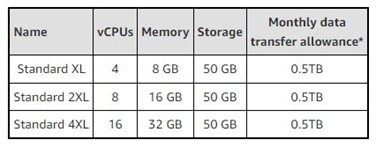|
Voiced by Amazon Polly |
Overview
This blog mainly deals with a new release service, Amazon Lightsail for Research. This new service enables scholars and researchers to quickly and easily build and maintain high-performance CPU or GPU research computers in the cloud, especially in AWS Cloud.
Pioneers in Cloud Consulting & Migration Services
- Reduced infrastructural costs
- Accelerated application deployment
Introduction
There is no need to use a personal research laptop or shared school computers to study bigger datasets or execute complex simulations. One can build research environments and use a web browser to view the application remotely on the research PC. Also, a simple web interface allows you to upload data and download it from your study computer quickly.
One can pay for the systems’ duration and be allowed to delete them whenever needed. Budgeting controls can also automatically turn off your computer when not in use. So that it will get to know precisely how much can spend for the usage of the research computer due to Lightsail for the Research’s inclusion of all-inclusive costs for computation, storage, and data transport.
Get Started with Amazon Lightsail for Research
- Open the AWS Console, and in the search bar, Search for Lightsail.
- Then you will get a landing page, as shown below. Click on the Lightsail for Research button next to the search bar.

- Click on Virtual computers in the left navigation menu.

- After that, click Create virtual computer to create a new research computer, and select the suitable software that needs to be preinstalled on the computer you want to create and implement as a research computer.
- As an initial step, select the application that needs to be installed on the research computer by selecting the appropriate AWS Region to be located. Lightsail supports Jupyter, RStudio, Scilab, and VSCodium. The other software can install as addon packages & extensions through the interface of the created IDE applications.

- After that, Select the required virtual hardware type, which includes a dedicated amount of compute (vCPUs or GPUs), SSD-based storage volume (disk) space, memory (RAM), and finally, a monthly data transfer allowance. Bundles get usually charged hourly on-demand basis.

- The Standard types available are compute-optimized, ideal for compute-bound applications such that we can benefit from high-performance processors.

- GPU types offer a high-performance platform for general-purpose GPU computation. These bundles can accelerate scientific, rendering, and scientific applications and workloads.

- After completion of selections, name the computer and select Create virtual computer for creating the research computer. After the computer is created and running, click on the Launch application button, then a new window will open, which displays the preinstalled application that was already selected.

Features of Lightsail for Research
You can create additional block-level storage volumes (disks) and attach them to an active Lightsail for Research virtual machine, just like you can with current Lightsail instances.
For that, select the storage section in the navigation pane.

A disc might serve as the primary store medium for data that needs regular, precise updates. You can create your storage by selecting Storage and Create disc options.

A snapshot is a point-in-time copy of your data that you can also make. There is an option to make a snapshot of your Lightsail for Research virtual machines and use it as a key point for building additional machines for data backup. The information required to restore your computer to its state when the snapshot was taken is usually stored in a snapshot.

Once restoring the computer is using a snapshot, a new computer with a larger size can be created with a snapshot backup. Create snapshots frequently to guard your data against corrupt applications or user errors.
One can apply cost control rules to better control the utilization and costs of Lightsail for Research virtual machines. The rules can be created in such a way as to stop running machines when their average CPU utilization falls under a specific threshold value in a specified time.

For instance, you may set up a rule to shut down a particular machine instantly if its CPU usage falls below or equal to 1% for 30 minutes. The computer will, after that, be shut down automatically by Lightsail for Research so that you won’t be charged for keeping it operating.
In the Usage menu section, one can view parameters like the cost estimate and usage hours for the created resources during a period.

Available Regions
Now Amazon Lightsail research is available in the following mentioned regions:
Canada (Central), US East (Ohio), Asia Pacific (Mumbai), US West (Oregon), Asia Pacific (Singapore), Asia Pacific (Sydney), Asia Pacific (Seoul), Asia Pacific (Tokyo), Europe (Frankfurt), Europe (London), Europe (Ireland), Europe (Stockholm) and Europe (Paris), Regions.
Conclusion
The Blog is helpful for students and researchers to achieve creating and managing for high-performance CPU & GPU research computers in a couple of clicks with the help of specified Integrated Development Environments like Jupyter, Rstudio, Scilab, VSCodium, or native Ubuntu Operating Systems, which come preinstalled on the research computer.
Upskill Your Teams with Enterprise-Ready Tech Training Programs
- Team-wide Customizable Programs
- Measurable Business Outcomes
About CloudThat
CloudThat is an award-winning company and the first in India to offer cloud training and consulting services worldwide. As a Microsoft Solutions Partner, AWS Advanced Tier Training Partner, and Google Cloud Platform Partner, CloudThat has empowered over 850,000 professionals through 600+ cloud certifications winning global recognition for its training excellence including 20 MCT Trainers in Microsoft’s Global Top 100 and an impressive 12 awards in the last 8 years. CloudThat specializes in Cloud Migration, Data Platforms, DevOps, IoT, and cutting-edge technologies like Gen AI & AI/ML. It has delivered over 500 consulting projects for 250+ organizations in 30+ countries as it continues to empower professionals and enterprises to thrive in the digital-first world.
FAQs
1. What are the benefits of a VPS?
ANS: – We got a lot of benefits from using a virtual private server, including scalability, affordability, security, and customizable resources.
2. What is a Virtual Private Server?
ANS: – The virtual private server, alternately known as an “instance”, ” allows users help to run websites and web applications in a highly secure environment, making it cost-effective.
3. What are snapshots?
ANS: – Snapshots are point-in-time backups of instances, block storage disks or databases. We can enable automatic snapshots on instances and disks to have Lightsail for Research to create snapshots for you. The snapshots can be used as baselines to create new resources or to back up the data. As well as, the snapshot usually contains whole data which is needed to restore the resource from the time at which the snapshot was taken. When you restore a resource by creating it from a snapshot, the new resource begins as replicating the original resource used to create the snapshot.

WRITTEN BY Bhanu Prakash K
K Bhanu Prakash is working as a Subject Matter Expert in CloudThat. He is proficient in Managing and configuring AWS Infrastructure as well as on Kubernetes and DevOps tools like Terraform, ansible, Jenkins, and Git. He is very keen on learning new technologies and publishing blogs for the tech community.


 Login
Login


 March 15, 2023
March 15, 2023 PREV
PREV











Comments